

With this in mind, I have chosen Kennedy as my starting point in building a collection of political games based on the Presidents and candidates of greatest interest to the Baby Boomers.
To further limit the collection's scope, I have primarily focused on boxed board games, with some inclusion of envelope and cardboard games.
The list of political games given within this page is by no means exhaustive. I would welcome any leads with regard to obtaining information on (or a copy of) any other game which fits the scope of this collection.
 Perhaps the most
familiar,
and certainly the most visually appealing, of the JFK-inspired games is
The
Exciting New Game of the Kennedys.
Perhaps the most
familiar,
and certainly the most visually appealing, of the JFK-inspired games is
The
Exciting New Game of the Kennedys.
Originally published by Harrison and Winter in 1962, this game was later sold under the Transco (Transogram) logo. Even without the change in company names, the earlier versions of this game may be identified by the more prototypical appearance of the game board and the unrounded card corners. Curiously, however, the game money in the older editions tends to be more crisp in appearance than in the later editions.
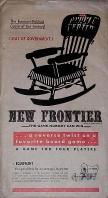 By
contrast, New
Frontier is a large envelope game of greater
scarcity and
limited graphic appeal. It was produced by Colorful Products in 1962,
and is stamped with a rather lengthy attribution: "ARTICLE ASSEMBLED BY
TRAINEES OF THE OCCUPATIONAL AND TRAINING CENTER OF HELP FOR RETARDED
CHILDREN,
INC."
By
contrast, New
Frontier is a large envelope game of greater
scarcity and
limited graphic appeal. It was produced by Colorful Products in 1962,
and is stamped with a rather lengthy attribution: "ARTICLE ASSEMBLED BY
TRAINEES OF THE OCCUPATIONAL AND TRAINING CENTER OF HELP FOR RETARDED
CHILDREN,
INC."
New Frontier may also have the distinction of being one of the first President-opoly games, being "a reverse twist on a favorite board game," Monopoly.
 Another game playing off the New Frontier concept
is
New Frontier-ola,
published by Einhorn-Victor Productions. The object of this game is "to
divest yourself of all of your holdings [...] so Bobby can't
investigate you for having monopolistic holdings." JFK's
rocker is featured within the game, as well as jabs at the Peace Corps,
Yale, and other aspects of Kennedy's life, family, and presidency.
Another game playing off the New Frontier concept
is
New Frontier-ola,
published by Einhorn-Victor Productions. The object of this game is "to
divest yourself of all of your holdings [...] so Bobby can't
investigate you for having monopolistic holdings." JFK's
rocker is featured within the game, as well as jabs at the Peace Corps,
Yale, and other aspects of Kennedy's life, family, and presidency. An
even more obscure game title is the similarly named Just
For Kicks -
New Frontier game, the title for which may also be
read as JFK's
New Frontier. This game was produced in 1963 by American
Marketing
in
Denver, Colorado.
An
even more obscure game title is the similarly named Just
For Kicks -
New Frontier game, the title for which may also be
read as JFK's
New Frontier. This game was produced in 1963 by American
Marketing
in
Denver, Colorado.
A third hand source notes that the game's designer produced only a few copies of this game before the Kennedy assassination. However, given this production data, a surprisingly large copies of this title did eventually find their way into Denver's secondhand outlets and thence into game collections nationwide.
While the majority of components reflect a low budget production, there are four unique plastic game tokens representing PT-109, a rocket ship, a football, and a bottle of scotch. The instructions for this title, as well as the Apple Polish and Boner cards, are done amusingly tongue-in-cheek, with less malice than some later political games would feature.
JFK's New Frontier holds an extra note of
irony in that the
last place player is awarded the position of Vice President. This
player "may remain at the party, but cannot make any decisions." Before
the production year of this game was over, JFK's Vice President was
indeed making decisions of national import.
 Bluff,
marketed by Saalfield Publishing in 1963, is a simple repackaging of
the Liar's Dice game. Only the cover, doubtlessly inspired by Kennedy's
and Khrushev's behavior in the Cuban missile crisis, gives this game a
place in a political games collection.
Bluff,
marketed by Saalfield Publishing in 1963, is a simple repackaging of
the Liar's Dice game. Only the cover, doubtlessly inspired by Kennedy's
and Khrushev's behavior in the Cuban missile crisis, gives this game a
place in a political games collection.
In a later printing of the Bluff game, Kennedy and Khrushev were replaced by a donkey and elephant on the cover. That variant was marketed around the time of the 1964 election.
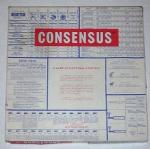 To date, I have found no
games pertaining solely to Lyndon Johnson
or his Administration. However, one game exists which gives equal
billing
to both Johnson and his '64 opponent, Barry Goldwater: Consensus
(Scientific
Game Development, '66 and '67).
To date, I have found no
games pertaining solely to Lyndon Johnson
or his Administration. However, one game exists which gives equal
billing
to both Johnson and his '64 opponent, Barry Goldwater: Consensus
(Scientific
Game Development, '66 and '67).
The cover art of this game is also somewhat nostalgic in featuring a drawing of an item familiar to many Baby Boomers, but which may yet be alien to many of the Millennial generation: a voting machine complete with levers, as opposed to the marker-filled, computer scanable ballots of today.
A fellow political game collector noted that he had seen this game title for sale in Princeton during the Nixon-Humphrey election period. At that time, Scientific Game Development had pasted Nixon's and Humphrey's names over Goldwater's and Johnson's.
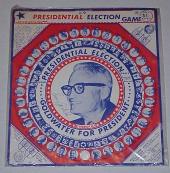 Another souvenir
of the
Johnson era comes from the Goldwater camp.
This single, large piece of cardboard comprises the entirety of the Presidential
Election Game: Goldwater For President (Kom-Pak,
1964). This
game is marked, "Approved Republican Nat'l Committee."
Another souvenir
of the
Johnson era comes from the Goldwater camp.
This single, large piece of cardboard comprises the entirety of the Presidential
Election Game: Goldwater For President (Kom-Pak,
1964). This
game is marked, "Approved Republican Nat'l Committee."
One unusual feature of this game is that all pieces are furnished as cutout parts, including the six-sided die. Another noteworthy feature is the small Barry Goldwater circle, which presumably was intended to fill the empty circle on the board reserved for the 36th President.
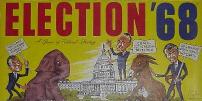 With Johnson
refusing to
seek reelection, the '68 election featured an open field of candidates.
Election '68
(CreaTek, 1967) does an excellent job of featuring the early candidates
in caricature form on cards, and shows the probable front runners for
each party on the cover: Richard Nixon for the Republicans; Robert
Kennedy for the Democrats; Johnson "presiding" over both.
With Johnson
refusing to
seek reelection, the '68 election featured an open field of candidates.
Election '68
(CreaTek, 1967) does an excellent job of featuring the early candidates
in caricature form on cards, and shows the probable front runners for
each party on the cover: Richard Nixon for the Republicans; Robert
Kennedy for the Democrats; Johnson "presiding" over both.
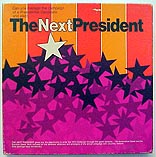 Perhaps
the most highly
detailed Presidential election game in terms of game mechanics comes
from the Nixon era.The Next
President,
by Reiss Associates focused on the upcoming 1972 contest. This game was
designed and developed by many of the same
people who formed the core of another game company in a different
field; namely,
the wargames company known as Simulations Publications, Inc., or SPI. The
Next President
attempted to give a level of realism beyond that of prior
election games by weighting strengths and weaknesses for each of the
various
candidates from both parties. As a bonus, it also gave provisions for
running various past Presidents and presidential candidates against
each other.
Perhaps
the most highly
detailed Presidential election game in terms of game mechanics comes
from the Nixon era.The Next
President,
by Reiss Associates focused on the upcoming 1972 contest. This game was
designed and developed by many of the same
people who formed the core of another game company in a different
field; namely,
the wargames company known as Simulations Publications, Inc., or SPI. The
Next President
attempted to give a level of realism beyond that of prior
election games by weighting strengths and weaknesses for each of the
various
candidates from both parties. As a bonus, it also gave provisions for
running various past Presidents and presidential candidates against
each other. 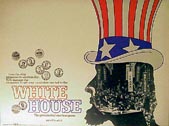 by Research Games, Inc. (RGI).
Campaign buttons from Muskie, Rockefeller, Lindsey, Wallace, and other
also-rans join those of Nixon and McGovern on the cover. Players vie
for the support of various states in the "primaries", then compare
totals in the "election". Because players must reduce their
hand for the election to the number held by the player who won the
fewest
states, White House is at best a game that
reinforces the
"focus on
the largest states to win" view. At worst, it is a race for California.
Still,
by using the candidates of the time, it provides a window into the 1972
election.
by Research Games, Inc. (RGI).
Campaign buttons from Muskie, Rockefeller, Lindsey, Wallace, and other
also-rans join those of Nixon and McGovern on the cover. Players vie
for the support of various states in the "primaries", then compare
totals in the "election". Because players must reduce their
hand for the election to the number held by the player who won the
fewest
states, White House is at best a game that
reinforces the
"focus on
the largest states to win" view. At worst, it is a race for California.
Still,
by using the candidates of the time, it provides a window into the 1972
election. While
the 1968 election was expected to be closely contested, there were no
such expectations regarding the 1972 campaign. The bookcase game, Who
Can Beat Nixon
(Harrison-Blaine, 1970), reflects the difficulty in defeating a popular
incumbent President... a surprisingly popular President, despite the
"lesser
of two evils" '72 election jokes. In fact, before the '72 election
there
was already discussion in the newspapers of a serious effort on Nixon's
behalf to repeal the two term limit on the Presidency.
While
the 1968 election was expected to be closely contested, there were no
such expectations regarding the 1972 campaign. The bookcase game, Who
Can Beat Nixon
(Harrison-Blaine, 1970), reflects the difficulty in defeating a popular
incumbent President... a surprisingly popular President, despite the
"lesser
of two evils" '72 election jokes. In fact, before the '72 election
there
was already discussion in the newspapers of a serious effort on Nixon's
behalf to repeal the two term limit on the Presidency.
Nixon's support, however, quickly eroded after the '72
election, as
more details regarding the Watergate incident became public. As a
result, with the aid of the Watergate-based titles, Nixon would seem to
have inspired the most games of any Republican President elected with
support of the Baby Boomers. At least seven games from the Watergate
period may be found: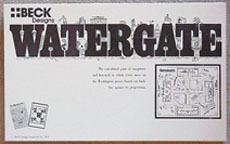
Research assistance would be appreciated. (Link corrected 1/21/03.)
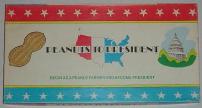 Peanuts
to
President (Daily Enterprises, 1978) makes no
explicit mention
of
Carter on the box, nor on the game board, nor the components. It does,
however,
feature a huge, toothy Carter-esque smile on the game board. It also
features
"peanut" money (labeled "In Peanuts We Trust") which is used in the
players'
attempts to buy votes.
Peanuts
to
President (Daily Enterprises, 1978) makes no
explicit mention
of
Carter on the box, nor on the game board, nor the components. It does,
however,
feature a huge, toothy Carter-esque smile on the game board. It also
features
"peanut" money (labeled "In Peanuts We Trust") which is used in the
players'
attempts to buy votes.
Players in Peanuts to President start out as peanut farmers and progress to election as governor before moving into the actual race for the Presidency.
 Following the peanut motif, and avoiding
use of the name "Carter" with a minor spelling adjustment, the Karter
Peanut
Shell Game (Morey and Neely, 1978) attempts to
mitigate its
harsh call
to "JOIN THE TAXPAYER'S REVOLT!" with the promise of "over a million
laughs." In historical hindsight, there is a certain irony in the
object of the game - to "waste, squander, throw away and spend all the
taxpayer's money" -
with Carter having been the only President from Johnson to Clinton to
preside
over even a single quarter in which government revenues equaled
government
spending.
Following the peanut motif, and avoiding
use of the name "Carter" with a minor spelling adjustment, the Karter
Peanut
Shell Game (Morey and Neely, 1978) attempts to
mitigate its
harsh call
to "JOIN THE TAXPAYER'S REVOLT!" with the promise of "over a million
laughs." In historical hindsight, there is a certain irony in the
object of the game - to "waste, squander, throw away and spend all the
taxpayer's money" -
with Carter having been the only President from Johnson to Clinton to
preside
over even a single quarter in which government revenues equaled
government
spending.
 References to "Silly's Beer" and "Panama's Golden Toll Lake" may be
found on the playing board and the play money. These serve as reminders
of "Billy Beer" and the return of the Panama Canal to Panama, and
insure that the
player is well aware of the President being lampooned.
References to "Silly's Beer" and "Panama's Golden Toll Lake" may be
found on the playing board and the play money. These serve as reminders
of "Billy Beer" and the return of the Panama Canal to Panama, and
insure that the
player is well aware of the President being lampooned.
Finally,
Save
Our
Bureaucrats (Gary
Tallman, 1980), or S.O.B. as given on the cover, features a
number of punchout cards that do, in fact, name President Carter
explicitly. Many of the Boondoggle cards feature events that actually
occurred during the Carter presidency. Some of the "boondoggles" are a
bit of a stretch (e.g., faulting Carter for civil servants in the Mount
St. Helens area continuing to get paid when their offices were closed
due to the volcano's eruption), but others provide a humorous view of
government waste during the period. S.O.B is also noted for its attempt
to trademark the word "SOB".
 Despite
an eight year tenure, there
would appear to be a dearth of
board games pertaining to our 38th President. To date I have found only
one board game made in the U.S. which features Ronald Reagan. That one
game,
which may be found with comparative ease, is Reaganomics
(Stockmann, 1981).
Despite
an eight year tenure, there
would appear to be a dearth of
board games pertaining to our 38th President. To date I have found only
one board game made in the U.S. which features Ronald Reagan. That one
game,
which may be found with comparative ease, is Reaganomics
(Stockmann, 1981).
Like the Karter Peanut Shell Game, there is a certain irony to this creation. The cover shows a neatly balanced budget, whereas the National Debt was run up continuously during each of the Reagan years.
Drawing from overseas game makers, however, provides another view of the Reagan Presidency. Opportunity (Invicta, 1983), is subtitled "or how to get out of tight situations," which somewhat reflects the perception at that time of Reagan being the "Teflon-coated President." Despite the picture and the dubious Presidential endorsement adorning the lid, however, Opportunity is a rather generic strategy game with equally generic pieces.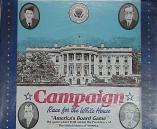 Bush,
like Ford, seems to have eluded
the eye of the board game designer. To date, the only U.S.-made
election board game I have located which depicts George Bush in any
manner is Campaign,
Race for the White House (J. R. Perri Corp., 1991).
Caricatures
of Bush and the three previous elected Presidents adorn the cover.
Bush,
like Ford, seems to have eluded
the eye of the board game designer. To date, the only U.S.-made
election board game I have located which depicts George Bush in any
manner is Campaign,
Race for the White House (J. R. Perri Corp., 1991).
Caricatures
of Bush and the three previous elected Presidents adorn the cover.
 Mid-East
Peace
(Columbia Games, 1990) does feature George Bush (among other
contemporary figures in world leadership) prominently on its cover. The
game, however, has little to do with the Bush Presidency save to serve
as a reminder of the days of Operations Desert Shield and Desert Storm.
Mid-East
Peace
(Columbia Games, 1990) does feature George Bush (among other
contemporary figures in world leadership) prominently on its cover. The
game, however, has little to do with the Bush Presidency save to serve
as a reminder of the days of Operations Desert Shield and Desert Storm.
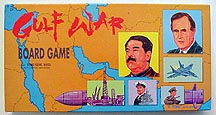
In a similar vein, a Gulf War inspired game featuring picture tokens
for both President Bush and Vice-President Quayle may be found if one
is willing to look as far afield as Kuala Lumpur. Gulf War
(Yimi
Sendiran Berhad, 1990) uses the characters of the time as a backdrop
for a simple
game only barely related to the actual events of the Gulf War. Closer
to
home, the box
bottom for a Gulf War simulation game made in the U.S., A
Line in the
Sand (TSR,1991), shows a photo of George Bush.
 Where's
George?, a 1993 supplement intended for use in
Avalon Hill's Tales
From the Floating Vagabond role playing line, provides its
own
oblique
reference to the passing Bush Presidency.
Where's
George?, a 1993 supplement intended for use in
Avalon Hill's Tales
From the Floating Vagabond role playing line, provides its
own
oblique
reference to the passing Bush Presidency.
Finally, a short scenario was released at the Origins game convention in 1992 for use with Mayfair's Road to the White House game. This scenario features the race between Bush, Clinton, and Perot.
In addition to this list, there is Trial of the Century. While that game mainly focuses on the O.J. Simpson trial, it makes some references to Whitewater.
Special mention should also be made of the Hot Springs National Park Historical District Game. While this title does not focus on Clinton, it shows his picture and takes ample opportunity to point out Hot Springs as the hometown of the 42nd President.
It is almost certain this list will prove by no means to be exhaustive for the Clinton Presidency.
A later variant, subtitled "The Great American Sell-Off Game" was marketed by Opoly Games and Things in 1995. This game is considerably more lighthearted than the earlier version. It features hush money (with a $3 bill added to the regular denomination mix) and the ability to sell off national parks and monuments.
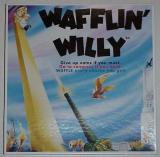 Perhaps
the most visually appealing game of the lot is one of the earliest as
well: Wafflin'
Willy (Right Angle Inc., 1993). The box is bright
and colorful,
the cards
and
pieces amusing, and the premise is lightheartedly simple - to
reach
the center
of the board with the most votes with your "Clinton" figure while
keeping
The Past from catching up to you.
Perhaps
the most visually appealing game of the lot is one of the earliest as
well: Wafflin'
Willy (Right Angle Inc., 1993). The box is bright
and colorful,
the cards
and
pieces amusing, and the premise is lightheartedly simple - to
reach
the center
of the board with the most votes with your "Clinton" figure while
keeping
The Past from catching up to you.
Particular note should be made of the Hillary Clinton caricature on the lid, dating back from the days of the Clintons' health care initiatives.
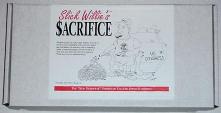 In
contrast to the Wafflin' Willy game, Slick
Willie's
$acrifice (RIGHT in Colorado, 1993) offers a "low
budget
exterior" - a white packing box with a label stuck on the front. It
also advises that "we are operating under a balanced budget, and we
will have a nicer box only when we have
more revenue." Various U.S. coins are used as player tokens, which
could
make at least one game piece (the quarter) somewhat cross collectible
if
the U.S. does not revert to the eagle backed quarter design in 2009.
In
contrast to the Wafflin' Willy game, Slick
Willie's
$acrifice (RIGHT in Colorado, 1993) offers a "low
budget
exterior" - a white packing box with a label stuck on the front. It
also advises that "we are operating under a balanced budget, and we
will have a nicer box only when we have
more revenue." Various U.S. coins are used as player tokens, which
could
make at least one game piece (the quarter) somewhat cross collectible
if
the U.S. does not revert to the eagle backed quarter design in 2009.
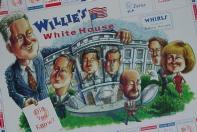 Almost
as soon as the name Monica Lewinsky had become a familiar news item, it
had also become a facet of a board game. Willie's
White
House (West Shore Games, 1998) offers players the
chance to
compete against each other by spending up to 8 years in the White
House. Unlike other Presidential games, however, players focus on
collecting money as a goal in itself to
win, rather than as a means to gain votes. This game challenges players
with hundreds of "Did You Know?" trivia questions regarding the
Clintons and the Clinton Administration, plus the opportunity to engage
in satirical wit via a selection of "Consider This!" cards.
Almost
as soon as the name Monica Lewinsky had become a familiar news item, it
had also become a facet of a board game. Willie's
White
House (West Shore Games, 1998) offers players the
chance to
compete against each other by spending up to 8 years in the White
House. Unlike other Presidential games, however, players focus on
collecting money as a goal in itself to
win, rather than as a means to gain votes. This game challenges players
with hundreds of "Did You Know?" trivia questions regarding the
Clintons and the Clinton Administration, plus the opportunity to engage
in satirical wit via a selection of "Consider This!" cards.
 The
latest addition to the Clinton game list is Clinton,
the Game of Scandal and Statesmanship by 2020
Associates. The
"box" for this game is a simple brown tube, adorned by a Clinton-faced
band to give the tube the appearance of a cigar. A cigar-shaped spinner
is also included as one of the game components. The object of the game
is to have your "Clinton" make it through two terms in office before
his
popularity falls to zero and
forces him to resign.
The
latest addition to the Clinton game list is Clinton,
the Game of Scandal and Statesmanship by 2020
Associates. The
"box" for this game is a simple brown tube, adorned by a Clinton-faced
band to give the tube the appearance of a cigar. A cigar-shaped spinner
is also included as one of the game components. The object of the game
is to have your "Clinton" make it through two terms in office before
his
popularity falls to zero and
forces him to resign.
2001 - ????: George W.
Bush
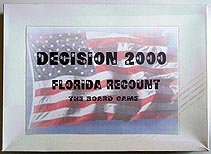
Honorable mention should go to Decision 2000
(Leona
Day, 2000), hand-produced in a run of only 10 copies shortly after the
2000 Presidential Election. If this game were a commercial production,
it would mark the fastest entry into the board game market for any
title inspired by a sitting U.S. President. The rules to the game are
admittedly tongue in cheek -- in one variant, the winner gets to be
President while the loser is appointed "ambassador to Chad [emphasis
mine]" -- but the data on the candidates, events and vote tallies make
this an interesting educational reference.
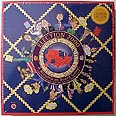 The
first commercially
printed game to feature George W. Bush is also based on the 2000
election. Election
2000, (Elephant Games, Inc., 2002), was
produced in a
limited run of 1000 copies. The game bills itself as "A Republican
Board Game," featuring cartoon renditions of Republican notables on the
cover in a favorable light while poking fun at the Clintons, Gore, and
the "Liberal" press. The game board and "butterfly ballot" cards serves
as a memory jog of events during both the 2000 election campaign and
the recount
process.
The
first commercially
printed game to feature George W. Bush is also based on the 2000
election. Election
2000, (Elephant Games, Inc., 2002), was
produced in a
limited run of 1000 copies. The game bills itself as "A Republican
Board Game," featuring cartoon renditions of Republican notables on the
cover in a favorable light while poking fun at the Clintons, Gore, and
the "Liberal" press. The game board and "butterfly ballot" cards serves
as a memory jog of events during both the 2000 election campaign and
the recount
process.
 Another special
nod goes to the first
commercially printed game to feature a sample ballot from the 2000
election. Chads (the Inaugural
Edition) is a
simple abstract game having nothing to do
with politics. However, the game's makers provide a sample Florida
butterfly ballot from the election showing the various Presidential
candidates. The ballot is punched alongside the game maker's own
selection - a write-in vote for CHADS.
Another special
nod goes to the first
commercially printed game to feature a sample ballot from the 2000
election. Chads (the Inaugural
Edition) is a
simple abstract game having nothing to do
with politics. However, the game's makers provide a sample Florida
butterfly ballot from the election showing the various Presidential
candidates. The ballot is punched alongside the game maker's own
selection - a write-in vote for CHADS.
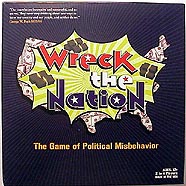 The first truly
anti-Bush game, and one of the few overtly anti-Republican games beyond
the Nixon years, made its debut in 2005. In Wreck the
Nation (JJ
Partners LLC),
players compete at squandering 1 trillion dollars on causes that do not
necessarily reflect the public good. The first player to spend all
their money has successfully wrecked the nation, and thus wins the game.
The first truly
anti-Bush game, and one of the few overtly anti-Republican games beyond
the Nixon years, made its debut in 2005. In Wreck the
Nation (JJ
Partners LLC),
players compete at squandering 1 trillion dollars on causes that do not
necessarily reflect the public good. The first player to spend all
their money has successfully wrecked the nation, and thus wins the game.
Wreck the Nation marks the beginning of a new -- and perhaps unfortunate -- web-centric trend in political games. The cards and game materials themselves only express their opposition to Bush administration policies in terms of innuendo. Only the Bush quote on the cover, the KidsAgainstBush.com attribution, and the preponderance of events tied to the Bush administration, tie this game explicitly to the George W. Bush Presidency. However, the game provides a web key via which the purchasers may go to www.wreckthenation.com and view all the underlying details for each card. The card pages viewable by the web mention administration officials by name, give additional details on each card's quote and/or event, and point to other web articles in that card's topic area. Unfortunately, the web interface provided is so cumbersomely link intensive (each card can only be examined in detail via its own link), and most card texts so littered with http://... strings, that the reading experience is painful at best. Perhaps more disturbing as a sign of the times, it is likely that within a few years the www.wreckthenation.com web site will cease to exist. As the publisher is currently not making the facts behind the cards available in summary form via a booklet or a downloadable single-source page, the history behind the Wreck the Nation cards will thus soon be lost to the games' owners.
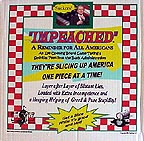 A game more in the typical
vein is Impeached
(BapBop LLC, 2005),
which bills itself as
"Taking a Satirical Peek into the Incompetence, Corruption, and
Stupidity of the Bush Administration." Players seek to avoid both
impeachment and being trapped in a war in Iraq on their "Quest for
Oil".
The box (a pizza box) and the style of humor are reminiscent of Slick
Willie's
$acrifice, but the materials are more colorful
A game more in the typical
vein is Impeached
(BapBop LLC, 2005),
which bills itself as
"Taking a Satirical Peek into the Incompetence, Corruption, and
Stupidity of the Bush Administration." Players seek to avoid both
impeachment and being trapped in a war in Iraq on their "Quest for
Oil".
The box (a pizza box) and the style of humor are reminiscent of Slick
Willie's
$acrifice, but the materials are more colorful 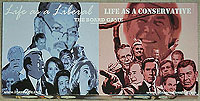 and
more laden
with
photos. As political games go, sales of this title have been relatively
brisk: the first run of 3,000 games is already sold out, and as of this
writing (4/19/2006) the authors are currently selling their second run
of 3,000.
and
more laden
with
photos. As political games go, sales of this title have been relatively
brisk: the first run of 3,000 games is already sold out, and as of this
writing (4/19/2006) the authors are currently selling their second run
of 3,000.
Yet another nod goes to Life as a Liberal/Life as a Conservative (Network Mall, 2003), which lampoons both sides of the political aisle. While George W. Bush is not the sole focus of the game, his picture appears on the cover. More importantly, most (but not all) of the game's events occurred during his Presidency..
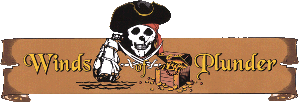 |
 |
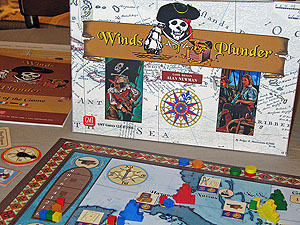 |
Shameless
self-promotion time. :-) Outside of my political
game
interests, I have been working as the developer on two games for GMT
Games. The first is Alan Newman's
Euro-style pirate game, Winds of Plunder,
which is currently available for sale: retail $45, but
some on line distributors offer it for as low as $29. The
second is Kevin McPartland's game of Polynesian exploration and
colonization, Conquest of
Paradise,
which is also available for sale from
GMT. On the left you can see a closeup for some of the Winds of Plunder components. Click on it to see an expanded view of the game. You can also follow the link to the GMT Games page for Winds of Plunder, or to the BoardGameGeek entry that has the game summary and other information. Similarly, on the right one may view the components for Conquest of Paradise. Again, you can also follow the link to the GMT Games page for Conquest of Paradise, or to that game's BoardGameGeek entry. |
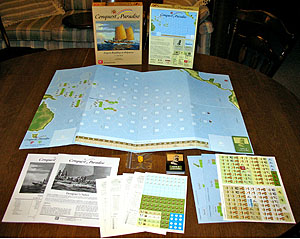 |